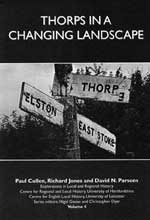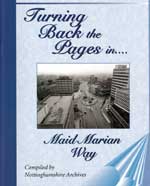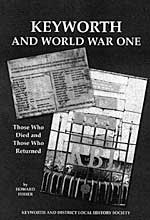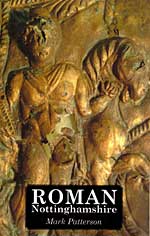Book reviews, Autumn 2011

THORPS IN A CHANGING LANDSCAPE
Paul Cullen, Richard Jones and David N. Parsons. (University of Hertfordshire Press). ISBN 798-1-902806-82-2
This book of just over two hundred pages is full of detailed information about places which are called Thorp or have thorp as an element of their name; that is, all those which are not throps. If you are a place-name junkie, as I am, this is a book for you. It examines the long-held premise that a thorp is a minor or satellite settlement of a larger or more important place, using new and old research to forward the authors' conclusions on what actually was a thorp. It also looks at the differences between the thorps of the Danelaw and the (mainly) throps of the English region.
The authors, using all the available linguistic, documentary, topographical and archaeological evidence, put forward a new hypothesis of what the origins of thorps might have been: that they were not merely 'secondary settlements of no specialized function relating to the last wave of Scandinavian land colonisation'. Looking at many test cases, including several Nottinghamshire thorps , Cullen and co find that they appeared in areas which had long been occupied, especially in good arable areas. There is strong evidence that they began as small, regularly planned settlements based on a single street - a linear form which survived in the 19th century in many cases. The premise put forward is that they were beginning to be established from the later 9th century to house the considerable labour force needed for crop production; they were, it is proposed, settlements intended for a dozen or so manorial tenants of more or less equal status; and that they did act as specialized areas away from the longer established livestock holding settlements.
Fascinating to those interested in settlement development and agricultural organisation, this book is well worth dipping into for its insights into a village type common to Nottinghamshire. Here the reader will find examples in Easthorpe and Westhorpe, Bilsthorp, Owthorp, Thorp-in-the-Glebe, Thorp-by-Newark etc. An interesting addition to the corpus of place-name books. It was co-written by Paul Cullen who, members may remember, gave an excellent lecture on Nottinghamshire place-names a few years back.
Barbara Cast
TURNING BACK THE PAGES IN MAID MARIAN WAY
Compiled by Nottinghamshire Archives ISBN 978-0-902751-71-2

The Turning Back the Pages series of books produced by the Nottinghamshire Archives team introduces its readers to the history of the county and city of Nottingham in an entertaining and innovative way by using archival photographs and other illustrations to tell the story of a particular element of history. In this, the latest book in the series, Chris Weir and Nick Smith turn the focus onto Maid Marian Way to show the development of the road and what the area looked like before the demolition teams got to work.
It cannot be disputed that, at the time this road was planned, traffic volumes were increasing in Nottingham and that some foresight was required to find a way of handling traffic in and around the west part of the city centre and that a road was needed to cope with increasing traffic levels, not only for the immediate future but the long term future as well. However, was it really necessary to so brutally destroy a large segment of the historic part of the city? The pictures in this book show exactly what was sacrificed to make way for Maid Marian Way: the old street pattern, St. Nicholas Church Trust school, Watson Fothergill's St. Nicholas church rectory, Collins' Almshouses, other lovely buildings of great interest and, it has to be admitted, some less lovely ones.
The same destructive attitude applied to the demolition to create the monstrous Broad Marsh shopping centre, an offense to the eye no matter what the current tinkering will produce.
Nottingham was once described as the 'Queen of the Midlands', a title now in contention as visits to our neighbouring cities of Derby and Leicester clearly demonstrate. Could not those responsible at the time for the planning and sanctioning the destruction of large parts of the historic city have been more creative, more sympathetic to the history and fine buildings of the area? Was there really no alternative? At least campaigning by the Civic Society prevented more destruction for a complete inner ring-road but innovative attempts to control traffic were apparently dropped after motorists complained. Other cities similar to Nottingham didn't make the same judgments as did the planners here and so those cities have retained good buildings and street layouts that Nottingham lost.
Maid Marian Way has been described as one of the ugliest streets in the UK. Whether this is a just description I leave readers to decide for themselves but really, is it so bad? In producing this book the Archives staff provide us with pictorial evidence on which to base a judgment. Setting old views against more recent ones with captions to establish the viewpoints is an excellent way to inform the reader and this book does this in a clear, unbiased and informative way.
This is a book which should be bought by every family in the city and its environs and used to seek to influence those we elect to office not to repeat the mistakes of those who planned and sanctioned the loss of so many buildings in the city in the past, and to seek to preserve what remains of the historic environment. Even a short walk around the city centre and the Lace Market clearly shows just what state some of the most important buildings of the city are in. It is to be hoped that action can be taken to preserve for the enjoyment of our grandchildren and their children elements of the city's history.
Buy this book, enjoy the pictures and the memories they induce, but also reflect on the fact that there are still treasures in this city which it is essential to preserve. Modern architecture of an imaginative and innovated design is surely welcome but in so doing we must not lose that which was excellent and innovative at the time it was erected.
The book costs £3.95 and can be bought from the Nottinghamshire Archives and major libraries. It can also be bought by post by sending a cheque for £6.95 (which includes £3.00 p&p) payable to Nottinghamshire County Council at Libraries, Archives and Information, 4th Floor, County Hall, West Bridgford, Nottingham, NG2 7QP
Howard Fisher
KEYWORTH AND WORLD WAR ONE: Those Who Died and Those Who Returned.
Howard Fisher. (Keyworth and District Local History Society). ISBN 978-0-9524602-4-4

Just like many towns and villages throughout the country, once the First World War had ended, Keyworth erected a war memorial to those who had died in the war. Placed in the parish church it listed the names of twenty seven men plus each one's rank and regiment. At the time the marble tablet was officially unveiled, those present at the ceremony would have known almost everyone listed there and which particular families they were drawn from. With the passage of time this communal knowledge would gradually dissipate especially as new families came to live there and the village grew in size. Nowadays only those with a specific family link might be expected to know something about any of those listed. To rectify this unsatisfactory state of affairs Howard Fisher has spent four years searching the relevant source material and the fruits of his research are now available to all in Keyworth and World War One published in 2011.
The Internet provides access to all manner of information including the World War One soldiers records - where they have survived. This means for some soldiers there is a wealth of available documentation but for others (the majority) there are only the basic details. In order to fill out the individual portraits the author has sought out family information courtesy of the census and parish records. Where the relevant service file has survived we have access to a complete description of the man in question taken from the medical report drawn up at the time of enlistment - even down to the colour of their eyes and chest size. The medical records log any subsequent injuries or illnesses including sexually transmitted diseases. We learn where they train and when and where they embark for the front. The personal records rarely if ever tell you anything about the circumstances surrounding an individual's death. The author has drawn on battalions' war diaries to try and rectify this and he reproduces what was written in the relevant diary in the lead up to each person's death. This information is not yet available over the Internet which necessitated repeated trips to the National Archives at Kew. Howard also provides details about the cemetery where each one was buried or the monuments bearing their names in the case of those whose bodies were never recovered. Searching the various electronic indexes via the Internet using the keyword 'Keyworth' enabled the author to pinpoint a further five individuals with a connection to the village who died in the war but whose names do not appear on the Keyworth memorial. Their profiles are also included in this book. Repeating the keyword search on all the extant service records brings up the records of some who survived the war. This has allowed Howard Fisher to create short profiles for a further twenty three local men who fought in the war. There were quite a lot more whose records have not survived. The Keyworth Absent Voters list for 1918 provides the service number and regimental details for a further forty five men and the author reproduces this information at the tail end of his book along with twenty seven more men where the specific service information was not provided. He ends with a further three local people where service details are lacking but who are known to have served in the war. Included here is the only woman mentioned in the book, Ellen Disney, who was a staff nurse in Queen Alexandra's Nursing Corps.
Where the author has gained access to photographs of the people in question these are included. We have some photographs of individual graves along with general shots taken at each of the cemeteries. Also featured are a number of photographs of soldiers at the front, reproduced by courtesy of the Imperial War Museum. It all helps to make for a most attractive publication which should ensure that 'We will remember them!'
Stephen Zaleski
The book costs £7.50 and is available from Keyworth Post Office or from the author and Keyworth & District Local History Society. If to be posted an additional £3.00 is required to cover p&p. Cheques payable to the KDLHS.
ROMAN NOTTINGHAMSHIRE
Mark Patterson (Five Leaves Publications, Nottingham). ISBN 978-1-907869-12-9

Having a professional interest in history and involved as an amateur in local archaeology, I found this book both entertaining and informative.
My brief episodes with Malcolm Todd at Margidunum and Malcolm Dean at Broughton Lodge left me with the beginnings of a concept of the Romans in Nottinghamshire and the relative importance of the Fosse Way in the evolution of settled communities.
The thoroughness of Mark Patterson's research has successfully laid to rest the occasional flights of fancy of the more imaginative early archaeo-historians and by incorporating the most up-to-date material from the field research prior to the dualling of the A46, he has taken our knowledge into the twenty-first century.
For a piece of scholarship and research as broad-ranging as this, Mark has succeeded in producing a well illustrated book which is packed with information and yet remains eminently readable.
He uses a relaxed style of address which this reader found inviting, sadly not always the case with scholarly works.
For the student and savant alike, this book represents a body of work which, in any study of Nottinghamshire's history will rank as a work of reference to which we will return time and time again, not least for the invaluable bibliography as a source for inviting still further study and research.
Keith Barton